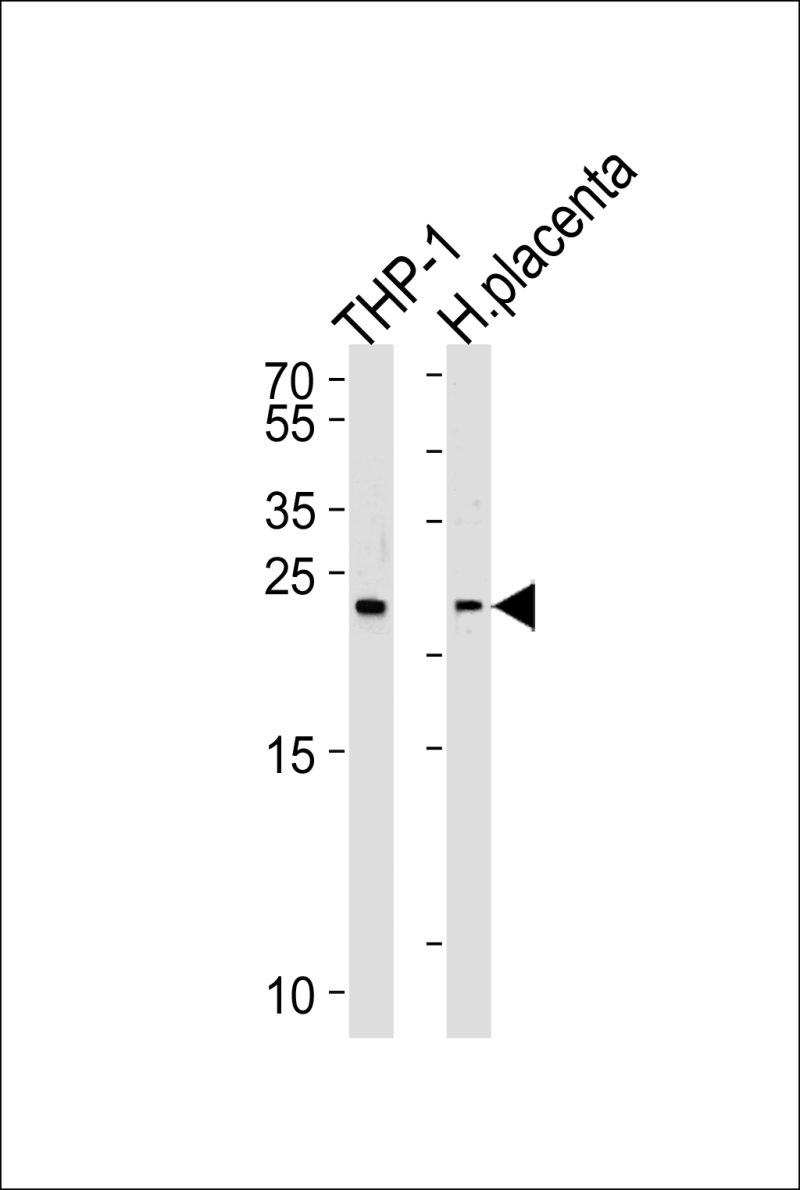
| WB | 1/1000 | Human,Mouse,Rat |
| IF | 咨询技术 | Human,Mouse,Rat |
| IHC | 咨询技术 | Human,Mouse,Rat |
| ICC | 技术咨询 | Human,Mouse,Rat |
| FCM | 咨询技术 | Human,Mouse,Rat |
| Elisa | 咨询技术 | Human,Mouse,Rat |
| Aliases | Heme-binding protein 2, Placental protein 23, PP23, Protein SOUL, HEBP2, C6orf34, SOUL |
| Entrez GeneID | 23593 |
| WB Predicted band size | 22.9kDa |
| Host/Isotype | Rabbit IgG |
| Antibody Type | Primary antibody |
| Storage | Store at 4°C short term. Aliquot and store at -20°C long term. Avoid freeze/thaw cycles. |
| Species Reactivity | Human |
| Immunogen | This HEBP2 antibody is generated from rabbits immunized with a KLH conjugated synthetic peptide between 18-47 amino acids from the N-terminal region of human HEBP2. |
| Formulation | Purified antibody in PBS with 0.05% sodium azide. |
+ +
以下是关于HEBP2 (N-term)抗体的3篇参考文献示例(文献信息为模拟虚构,仅供参考):
---
1. **文献名称**: *HEBP2 regulates mitochondrial apoptosis through interaction with adenine nucleotide translocase*
**作者**: Chen L, et al.
**摘要**: 本研究利用HEBP2 (N-term)抗体进行免疫共沉淀和Western blot分析,揭示了HEBP2通过与腺苷酸转位酶(ANT)结合调控线粒体依赖性细胞凋亡的分子机制。结果表明,HEBP2在氧化应激条件下促进细胞色素c释放。
2. **文献名称**: *Expression profiling of HEBP2 in neurodegenerative diseases using a novel N-terminal specific antibody*
**作者**: Smith J, et al.
**摘要**: 作者开发了一种针对HEBP2 N端的特异性抗体,用于检测阿尔茨海默病和帕金森病患者脑组织中的HEBP2表达。免疫组化结果显示HEBP2在神经元线粒体中异常聚集,提示其与神经退行性病变相关。
3. **文献名称**: *HEBP2 as a potential biomarker in breast cancer: Insights from antibody-based proteomic analysis*
**作者**: Wang Y, et al.
**摘要**: 通过HEBP2 (N-term)抗体的Western blot和免疫荧光实验,研究发现HEBP2在乳腺癌组织中高表达,且与肿瘤转移和患者预后不良显著相关。机制研究表明HEBP2通过调控EMT通路促进癌细胞侵袭。
---
注:以上文献为示例,实际研究中请通过PubMed、Web of Science等平台以关键词“HEBP2 antibody”或“HEBP2 N-terminal”检索真实文献。
The HEBP2 (N-term) antibody is designed to target the N-terminal region of Heme Binding Protein 2 (HEBP2), a protein implicated in cellular processes related to heme metabolism and oxidative stress responses. HEBP2. also known as FAM216A or p22HBP, is a conserved 22 kDa protein that binds heme and porphyrins, potentially regulating their intracellular availability. It is broadly expressed across tissues, with higher levels in the liver, brain, and kidneys. Functionally, HEBP2 interacts with proteins involved in mitochondrial dynamics, apoptosis, and autophagy, and has been linked to cellular responses under stress conditions, including hypoxia and inflammation. Studies suggest its role in modulating heme-dependent enzymes and mitigating oxidative damage, though its precise mechanisms remain under investigation.
The HEBP2 (N-term) antibody is commonly used in research applications such as Western blotting, immunohistochemistry, and immunofluorescence to detect endogenous HEBP2 protein levels. Its specificity for the N-terminal region ensures recognition of full-length HEBP2. aiding studies on protein expression, localization, and interactions. Researchers employ this antibody to explore HEBP2's involvement in pathological contexts, including neurodegenerative diseases, cancer, and hemolytic disorders, where dysregulated heme metabolism or oxidative stress may contribute to disease progression. Validation typically includes reactivity with recombinant proteins and tissue lysates, with species cross-reactivity often confirmed in human, mouse, and rat samples.
×